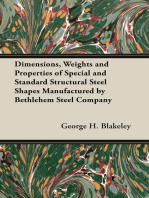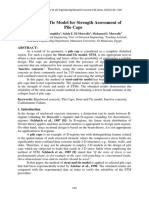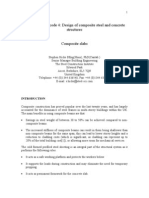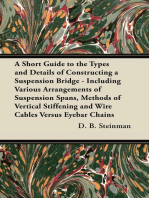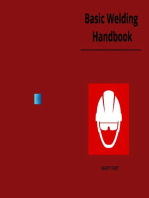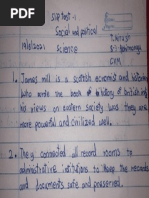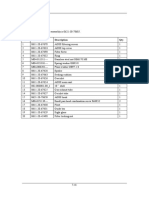NSCNov03 AD268
NSCNov03 AD268
Uploaded by
davethiyaguCopyright:
Available Formats
NSCNov03 AD268
NSCNov03 AD268
Uploaded by
davethiyaguOriginal Description:
Original Title
Copyright
Available Formats
Share this document
Did you find this document useful?
Is this content inappropriate?
Copyright:
Available Formats
NSCNov03 AD268
NSCNov03 AD268
Uploaded by
davethiyaguCopyright:
Available Formats
ADVISORY DESK
The aim of this feature is to share up-dates, design tips and answers to queries. The Steel Construction Institute
provides items which, it is hoped, will prove useful to the industry.
AD 268
Bolt Lengths Table 3,
BS 5950-2: 2001
Following the publication of AD 263
concerning the limitations of bolt grades in
BS 5950-1 and Eurocode 3, we have received
several questions regarding Clause 4.3.1 and
Table 3 to BS 5950-2: 2001. This Advisory
Desk note addresses questions about two
issues. The first is the length of the bolt
protrusion beyond the nut and the second is
the number of threads in the stressed length.
Figure 1 gives the definition of various lengths
referred to in this AD.
Bolt protrusion
The first line of Clause 4.3.1 states All bolt
shanks shall protrude beyond the end of the
nut by at least one thread pitch after
tightening. This is a simple and enforceable
rule for all bolts which is relatively easy to
check even on site. It results in full thread
engagement between the nut and shank,
thereby ensuring that any tension in the shank
is transferred to the nut. The minimum
theoretical bolt length should be calculated on
this basis, allowing for the thickness of the
nut, washer, grip and bolt protrusion.
The note under the first sentence adds the
advice that a bolt length calculated with at
least one further full thread pitch in addition
to the theoretical length required will normally
ensure adequate allowance for tolerances.
The grip length (the sum of the ply thickness)
can vary due to the rolling tolerances of the
plies and paint thickness, and the bolt also has
manufacturing tolerances; however one
additional full thread pitch on top of the
theoretical bolt length will usually suffice.
This is the same as the old rule of thumb in
steelwork that a bolt should have two full
threads beyond the nut, one for thread
engagement and one for tolerances. However,
the designer should give further consideration
to particular cases where greater than normal
tolerances need to be accommodated. One
example is where the paint coatings are
unexpectedly thick. Another is where
galvanizing is also unexpectedly thick on the
faces of the plies, as can occur with Silicon
rich steel.
ductile the bolt, as can be seen from the
minimum ductility requirements for bolts
materials given in Table 3, EN ISO 898-1: 1999.
In addition, the length of the threaded portion
in the stressed length has been shown to
influence considerably the ductility of the bolt
(fig. 1). Table 3, BS 5950-2: 2001 reflects this by
specifying longer threaded portions in the
stressed length for higher grade bolts and
higher tension loads: in other words, the
minimum threaded portions in Table 3 are the
means to ensure that bolts have sufficient
ductility to be used safely in normal structural
connections. Fully threaded bolts have greater
ductility than short threaded ones and are
preferable where maximum ductility of
connections is required.
It can be seen that no provision has been made
for Grade 12.9 and 14.9 bolts in Table 3,
BS 5950-2: 2001. They are considered to have
insufficient ductility to be used safely in
Table 3 gives minimum lengths (in addition to
the thread run-out) of the threaded portion in
the stressed length, b in Fig. 1, in terms of a
number of thread pitches, for the various bolt
grades and loading conditions. The reason for
this requirement is related to ductility.
In general, the higher the bolt grade the less
Contact: Thomas Cosgrove
Email: t.cosgrove@steel-sci.com
Table 3 from BS 5950-2: 2001 reproduced with the
permission of the British Standards Institution licence
number 2003SK/118. BSI publications can be obtained
from BSI Customer Services, 389 Chiswick High Road,
London W4 4AL. United Kingdom. (Tel + 44 (0) 20 8996
9001). Email: cservices@bsi-global.com
Fig. 1. Tensile behaviour of bolts.
Grade 4.6
Grade 8.8a
Grade 10.9b
Non-preloaded in shear only
Non-preloaded otherwise
Preloaded
Type of bolts
Threads under the nut
normal structural connections, as explained in
AD 263.
When specifying large diameter high-grade
bolts in conjunction with short grip lengths,
the designer should be careful because the
minimum threaded portion required may
exceed the grip length. Hence it is a good rule
of thumb to maintain a minimum ply
thickness in a joint greater than or equal to
half the nominal bolt diameter used in the
connection, where possible.
Including general grade bolts to BS 4395-1
Including higher grade bolts to BS 4395-2
Fig. 2. BS 5950-2: 2001 Table 3 Clear Threads
Nominal bolt diameter
M12 M16 M20 M22 M24 M27 M30 M33 M36
Pitch (mm)
1.75 2.00 2.50 2.50 3.00 3.00 3.50 3.50 4.00
Fig. 3. The coarse pitch of screw threads for the normal range of ISO metric structural bolts.
You might also like
- Method of Statement For Testing & Commissioning of Fire Alarm SystemDocument7 pagesMethod of Statement For Testing & Commissioning of Fire Alarm SystemKarim Amer100% (1)
- Work Inspection Process FlowchartDocument16 pagesWork Inspection Process Flowchartdavethiyagu100% (5)
- Unit 7 (DESIGN DETAILS OF BEAMS)Document35 pagesUnit 7 (DESIGN DETAILS OF BEAMS)Zara Nabilah94% (16)
- BS 3551-1962 Specification For Alloy Steel ShacklesDocument24 pagesBS 3551-1962 Specification For Alloy Steel ShacklesLEADANo ratings yet
- Bs 302-Part2-1987 (Steel Wire Ropes-Specification For Ropes FDocument13 pagesBs 302-Part2-1987 (Steel Wire Ropes-Specification For Ropes Fcelsocarvalh100% (1)
- Macalloy Bars For Use in Post Tensioning ApplicationDocument21 pagesMacalloy Bars For Use in Post Tensioning Applicationsanusi69No ratings yet
- All-in-One Manual of Industrial Piping Practice and MaintenanceFrom EverandAll-in-One Manual of Industrial Piping Practice and MaintenanceRating: 5 out of 5 stars5/5 (1)
- Reinforced Concrete Buildings: Behavior and DesignFrom EverandReinforced Concrete Buildings: Behavior and DesignRating: 5 out of 5 stars5/5 (1)
- Dimensions, Weights and Properties of Special and Standard Structural Steel Shapes Manufactured by Bethlehem Steel CompanyFrom EverandDimensions, Weights and Properties of Special and Standard Structural Steel Shapes Manufactured by Bethlehem Steel CompanyNo ratings yet
- Weld Like a Pro: Beginning to Advanced TechniquesFrom EverandWeld Like a Pro: Beginning to Advanced TechniquesRating: 4.5 out of 5 stars4.5/5 (6)
- Tool Box Talks - ReinforcementDocument7 pagesTool Box Talks - ReinforcementdavethiyaguNo ratings yet
- Bolt Lengths - Table 3, BS 5950-2: 2001: Advisory DeskDocument3 pagesBolt Lengths - Table 3, BS 5950-2: 2001: Advisory DesktfvnjyNo ratings yet
- Limit States in RCCDocument15 pagesLimit States in RCCprashmceNo ratings yet
- Limit State of Serviceability in RCCDocument19 pagesLimit State of Serviceability in RCCprashmceNo ratings yet
- TEK 12-6 Reinforcement & Connectors (2007)Document6 pagesTEK 12-6 Reinforcement & Connectors (2007)B0B_PNo ratings yet
- C I 3304 Detailing CornerDocument5 pagesC I 3304 Detailing CornerNono_geotecNo ratings yet
- BS 302 - 1-1987 Stranded Steel Wire Ropes PDFDocument16 pagesBS 302 - 1-1987 Stranded Steel Wire Ropes PDFAlsonChin0% (1)
- Strut-and-Tie Model For Strength Assessment of Pile CapsDocument24 pagesStrut-and-Tie Model For Strength Assessment of Pile CapsPrashant JhaNo ratings yet
- BS 302-2 Stranded Steel Wire RopesDocument15 pagesBS 302-2 Stranded Steel Wire RopesThimira Bandara EkanayakeNo ratings yet
- BS 1139-1.1 1990Document14 pagesBS 1139-1.1 1990kingkingking198867% (6)
- P-19-83 (Steel Nuts & Bolts)Document14 pagesP-19-83 (Steel Nuts & Bolts)Sarmad HussainNo ratings yet
- Is 4000 High Strength Bolts in Steel Structures-Code of Prac.183134814Document15 pagesIs 4000 High Strength Bolts in Steel Structures-Code of Prac.183134814Narayan RoyNo ratings yet
- MEE Avoiding Bolt FailuresDocument2 pagesMEE Avoiding Bolt Failuresridwan347No ratings yet
- NAFI Joint Design 3 (2001) - Bolts, Coach Screws & Timber ConnectorsDocument16 pagesNAFI Joint Design 3 (2001) - Bolts, Coach Screws & Timber Connectorssteveh49No ratings yet
- Esdu 68045Document6 pagesEsdu 68045rinoceronte09No ratings yet
- Specifying Bolt Length For High-Strength Bolts: Manual of Steel ConstructionDocument12 pagesSpecifying Bolt Length For High-Strength Bolts: Manual of Steel Constructionpreds1717No ratings yet
- Bond, Anchor and ShearDocument15 pagesBond, Anchor and ShearBatepola BacNo ratings yet
- Dimensions and Tolerances of Hot Rolled Round Steel Rods For Wire DrawingDocument3 pagesDimensions and Tolerances of Hot Rolled Round Steel Rods For Wire DrawingSamwel TarimoNo ratings yet
- RC Detailing To EuroCode 2Document39 pagesRC Detailing To EuroCode 2ahmadNo ratings yet
- Shear Check As Per CodesDocument10 pagesShear Check As Per Codesabdul samadNo ratings yet
- Part-Ii: Chapter - 4. Fabrication and ErectionDocument14 pagesPart-Ii: Chapter - 4. Fabrication and ErectionAshish PatelNo ratings yet
- CONEXÃODocument2 pagesCONEXÃORui GavinaNo ratings yet
- Moment Resistant End Plate-As Per Euro CodeDocument23 pagesMoment Resistant End Plate-As Per Euro CodeBhushan PatilNo ratings yet
- Control of Flexural Cracks by Jack C. McCormacDocument9 pagesControl of Flexural Cracks by Jack C. McCormacbig_one214No ratings yet
- Seamless Copper Water Tube (Metric) : Standard Specification ForDocument7 pagesSeamless Copper Water Tube (Metric) : Standard Specification ForCarlos VegaNo ratings yet
- The Interaction of Ductility, Strength, and Stiffness IN Simple Shear Connections With Shear and Axial LoadDocument21 pagesThe Interaction of Ductility, Strength, and Stiffness IN Simple Shear Connections With Shear and Axial LoadsaudimanNo ratings yet
- Astm A810-01Document4 pagesAstm A810-01ditherNo ratings yet
- Blue Book' Tables For Bolts, Welds and Webs: TechnicalDocument3 pagesBlue Book' Tables For Bolts, Welds and Webs: TechnicalJacob GrechNo ratings yet
- More Work Is RequiredDocument8 pagesMore Work Is RequiredCarlos ShuntaNo ratings yet
- Weld Design For Beam End Plate Connections in Accordance With SCI P358Document1 pageWeld Design For Beam End Plate Connections in Accordance With SCI P358Anonymous 37PvyXCNo ratings yet
- Powell (1983) - Ductile Anchor Bolts For Tall ChimneysDocument11 pagesPowell (1983) - Ductile Anchor Bolts For Tall Chimneystimur sibaevNo ratings yet
- Improvements To C303 Bar Wrapped Steel Cyl Conc Pipe RMielke 2 7 11 - 1 - UPLOADEDDocument12 pagesImprovements To C303 Bar Wrapped Steel Cyl Conc Pipe RMielke 2 7 11 - 1 - UPLOADEDMartin HumbirdNo ratings yet
- Design Guidelines For Partially Composite BeamsDocument5 pagesDesign Guidelines For Partially Composite BeamsMạnh ThànhNo ratings yet
- Bs 302-Part1-1987 (Steel Wire Ropes-Specification For GeneralDocument14 pagesBs 302-Part1-1987 (Steel Wire Ropes-Specification For Generalcelsocarvalh100% (1)
- Astm A381Document7 pagesAstm A381hadeNo ratings yet
- Fabrication of Reinforcement: CaresDocument6 pagesFabrication of Reinforcement: CaresRamraj RamachandranNo ratings yet
- Siemens - Bus Joint FundamentalsDocument2 pagesSiemens - Bus Joint FundamentalsgfortiNo ratings yet
- Alloy Steel Shackles BS-3551Document24 pagesAlloy Steel Shackles BS-3551Moheb BotrosNo ratings yet
- TGN-BC-01 Tack Welding of Reinforcement BarDocument8 pagesTGN-BC-01 Tack Welding of Reinforcement Barnaseema1No ratings yet
- En 1994 - Eurocode 4: Design ofDocument24 pagesEn 1994 - Eurocode 4: Design ofchono_kolevNo ratings yet
- 07cb0663-d04c-4864-955d-bf609dc759c1Document6 pages07cb0663-d04c-4864-955d-bf609dc759c1x620100% (1)
- A Short Guide to the Types and Details of Constructing a Suspension Bridge - Including Various Arrangements of Suspension Spans, Methods of Vertical Stiffening and Wire Cables Versus Eyebar ChainsFrom EverandA Short Guide to the Types and Details of Constructing a Suspension Bridge - Including Various Arrangements of Suspension Spans, Methods of Vertical Stiffening and Wire Cables Versus Eyebar ChainsNo ratings yet
- How to prepare Welding Procedures for Oil & Gas PipelinesFrom EverandHow to prepare Welding Procedures for Oil & Gas PipelinesRating: 5 out of 5 stars5/5 (1)
- Composite Structures of Steel and Concrete: Beams, Slabs, Columns and Frames for BuildingsFrom EverandComposite Structures of Steel and Concrete: Beams, Slabs, Columns and Frames for BuildingsNo ratings yet
- Flexible Glass: Enabling Thin, Lightweight, and Flexible ElectronicsFrom EverandFlexible Glass: Enabling Thin, Lightweight, and Flexible ElectronicsSean M. GarnerNo ratings yet
- Spot Welding Interview Success: An Introduction to Spot WeldingFrom EverandSpot Welding Interview Success: An Introduction to Spot WeldingNo ratings yet
- Galp Energia Appointment LetterDocument7 pagesGalp Energia Appointment LetterdavethiyaguNo ratings yet
- 4, 6, 9, 3, 7 Largest Observation 9 Smallest Observation 3Document2 pages4, 6, 9, 3, 7 Largest Observation 9 Smallest Observation 3davethiyaguNo ratings yet
- Triangles and Its PropertiesDocument5 pagesTriangles and Its PropertiesdavethiyaguNo ratings yet
- 8-3 Slip Test 1 - HistoryDocument1 page8-3 Slip Test 1 - HistorydavethiyaguNo ratings yet
- 8 Social Science (19.06.21) .Document1 page8 Social Science (19.06.21) .davethiyaguNo ratings yet
- QAQC Meeting - 2020 - TemplateDocument9 pagesQAQC Meeting - 2020 - TemplatedavethiyaguNo ratings yet
- UG Admission DetailsDocument1 pageUG Admission Detailsdavethiyagu100% (1)
- Dhan Us KodiDocument3 pagesDhan Us KodidavethiyaguNo ratings yet
- Astm F15 06: NFP A 701Document2 pagesAstm F15 06: NFP A 701davethiyaguNo ratings yet
- Employee HandbookDocument197 pagesEmployee HandbookdavethiyaguNo ratings yet
- Travel Triangle: Outbound Holiday PackagesDocument35 pagesTravel Triangle: Outbound Holiday PackagesdavethiyaguNo ratings yet
- Gyproc Productbrochures AcousticceilingsbrochureDocument48 pagesGyproc Productbrochures AcousticceilingsbrochuredavethiyaguNo ratings yet
- Bison KitDocument1 pageBison KitdavethiyaguNo ratings yet
- How To Test Anchors To Bs 8539 05-05-14Document4 pagesHow To Test Anchors To Bs 8539 05-05-14davethiyaguNo ratings yet
- Quality Does MatterDocument27 pagesQuality Does MatterdavethiyaguNo ratings yet
- WRAS+Approvals+Guidance+App+a+V2 8+apr+07Document14 pagesWRAS+Approvals+Guidance+App+a+V2 8+apr+07davethiyaguNo ratings yet
- Sample Method Statement For Nuclear TestingDocument10 pagesSample Method Statement For Nuclear TestingdavethiyaguNo ratings yet
- Camp Inspection Form PDFDocument12 pagesCamp Inspection Form PDFLexNo ratings yet
- Second Floor Plan SCALE:1:50: Common Music and Dance AreaDocument1 pageSecond Floor Plan SCALE:1:50: Common Music and Dance AreaRiya MehtaNo ratings yet
- Part - 6 Distribution Boards: 1.0 GeneralDocument5 pagesPart - 6 Distribution Boards: 1.0 GeneralKhyle Laurenz DuroNo ratings yet
- 978 1 63057 050 7 - Toc PDFDocument10 pages978 1 63057 050 7 - Toc PDFroger njeimNo ratings yet
- Steel Bridge Design Brief 2024Document6 pagesSteel Bridge Design Brief 2024TelexxNo ratings yet
- ASTM D 4442-07: Standard Test Methods For Direct Moisture Content Measurement of Wood and Wood-Based MaterialsDocument22 pagesASTM D 4442-07: Standard Test Methods For Direct Moisture Content Measurement of Wood and Wood-Based MaterialsLea Mae CabancaNo ratings yet
- Heat Pump AssignmentDocument10 pagesHeat Pump AssignmentOmer NadeemNo ratings yet
- Innovinc Aspire - Company ProfileDocument28 pagesInnovinc Aspire - Company Profilekrhimanshu0505No ratings yet
- AHU Presentation 2013Document12 pagesAHU Presentation 2013bennNo ratings yet
- Analysing Intl Tunnelling Costs Worcester (2012)Document108 pagesAnalysing Intl Tunnelling Costs Worcester (2012)alwil144548100% (1)
- 1 s2.0 S2352012424001255 MainDocument15 pages1 s2.0 S2352012424001255 MainmohamedNo ratings yet
- Star Tower - PresentationDocument86 pagesStar Tower - PresentationSukh JohalNo ratings yet
- Transmission Report Lesco World BankDocument294 pagesTransmission Report Lesco World BankmehtabpkNo ratings yet
- 7.1.30.2 Parts List: S/N P/N Description QtyDocument22 pages7.1.30.2 Parts List: S/N P/N Description QtyRene GonzalesNo ratings yet
- Failure of Retaining Wall (Dam) Due To Water Pressure.Document42 pagesFailure of Retaining Wall (Dam) Due To Water Pressure.RajanRanjanNo ratings yet
- Electrical Cables and ConnectorsDocument2 pagesElectrical Cables and Connectorsaldy priyoNo ratings yet
- AIM:-Service Positive Crankcase Ventilation System: Practical - 3Document6 pagesAIM:-Service Positive Crankcase Ventilation System: Practical - 3saiyed amanNo ratings yet
- Method Statement for SlabDocument12 pagesMethod Statement for Slabaziz adelNo ratings yet
- List of Establishments 2018revisedDocument170 pagesList of Establishments 2018revisedTricia Mae Evangelista100% (1)
- 2 - Exploration, Sampling, and in Situ SoilDocument50 pages2 - Exploration, Sampling, and in Situ SoilHaider Yousef100% (1)
- Dokumen - Tips - PPT On Training Civil Report On ShutteringDocument42 pagesDokumen - Tips - PPT On Training Civil Report On ShutteringSachin KumarNo ratings yet
- Lec7 Ballast WebDocument11 pagesLec7 Ballast WebchristopherapssNo ratings yet
- C/C C/C C/C C/C C/C C/C C/C C/C: UrinalsDocument1 pageC/C C/C C/C C/C C/C C/C C/C C/C: Urinalsexecutive engineerNo ratings yet
- Yah-D Ceiling Air Handling UnitDocument19 pagesYah-D Ceiling Air Handling UnitMichael FutolNo ratings yet
- KMBD Mech BoostersDocument2 pagesKMBD Mech BoostersMark V FarrellNo ratings yet
- Architect's Facade ManualDocument240 pagesArchitect's Facade ManualLaura Gardner93% (15)
- Welding of Duplex Stainless SteelDocument7 pagesWelding of Duplex Stainless SteelAnthony YU100% (1)
- Description of Cumulative DOE-2.3 Version 50h Bug Fixes (Since Initial Public Release of Version 49c)Document2 pagesDescription of Cumulative DOE-2.3 Version 50h Bug Fixes (Since Initial Public Release of Version 49c)Pallab DasguptaNo ratings yet
- 16.24-TMSS-01 (REV.01) - Metallic Cable Tray SystemsDocument3 pages16.24-TMSS-01 (REV.01) - Metallic Cable Tray SystemsbaraaNo ratings yet









